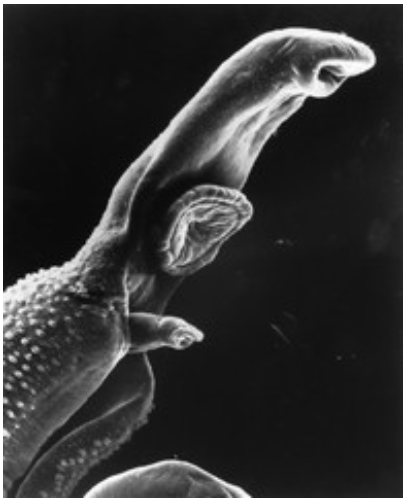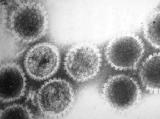13.2: Introduction to the Immune System
- Last updated
- Save as PDF
- Page ID
- 85286
Worm Attack!
Does this organism look like a space alien? A scary creature from a nightmare? In fact, it’s a 1-cm long worm in the genus Schistosoma. It may invade and take up residence in the human body, causing a very serious illness known as schistosomiasis. The worm gains access to the human body while it is in a microscopic life stage. It enters through a hair follicle when the skin comes into contact with contaminated water. The worm then grows and matures inside the human organism, causing disease.

Host vs. Pathogen
The Schistosoma worm has a parasitic relationship with humans. In this type of relationship, one organism, called the parasite, lives on or in another organism, called the host. The parasite always benefits from the relationship and the host is always harmed. The human host of the Schistosoma worm is clearly harmed by the parasite when it invades the host’s tissues. The urinary tract or intestines may be infected, and signs and symptoms may include abdominal pain, diarrhea, bloody stool, or blood in the urine. Those who have been infected a long time may experience liver damage, kidney failure, infertility, or bladder cancer. In children, Schistosoma infection may cause poor growth and difficulty learning. Table \(\PageIndex{1}\) lists some of the microscopic pathogens, their images, description, and the diseases that they cause.
Like the Schistosoma worm, many other organisms can make us sick if they manage to enter our body. Any such agent that can cause disease is called a pathogen. Most pathogens are microorganisms, although some, such as the Schistosoma worm, are much larger. In addition to worms, common types of pathogens of human hosts include bacteria, viruses, fungi, and single-celled organisms called protists. You can see examples of each of these types of pathogens in Table \(\PageIndex{1}\). Fortunately for us, our immune system is able to keep most potential pathogens out of the body or to quickly destroy them if they do manage to get in. When you read this chapter, you’ll learn how your immune system usually keeps you safe from harm — including from scary creatures like the Schistosoma worm!
| Type of Pathogen | Example and their Image | Description | Human Disease caused by pathogens of that type |
|---|---|---|---|
| Bacteria |
such as Escherichia coli |
Single-celled organisms without a nucleus | Strep throat, staph infections, tuberculosis, food poisoning, tetanus, pneumonia, syphilis |
| Viruses |
such as Herpes simplex |
Particles that reproduce by taking over living cells. | Common cold, flu, genital herpes, cold sores, measles, AIDS, genital warts, chickenpox, smallpox |
| Fungi |
such as Trichophyton rubrum |
Organisms with a nucleus that grow as single cells or tread-like filaments | Ringworm, athlete's foot, tineas, candidiasis, histoplasmosis |
| Protozoa |
Such as Giarida lamblia |
A single-celled organism with a nucleus | Malaria, Traveler's diarrhea, giardiasis, trypanosomiasis (sleeping sickness) |
What is the Immune System?
The immune system is a host defense system. It comprises many biological structures —ranging from individual white blood cells to entire organs — as well as many complex biological processes. The function of the immune system is to protect the host from pathogens and other causes of disease such as tumor cells. To function properly, the immune system must be able to detect a wide variety of pathogens. It also must be able to distinguish the cells of pathogens from the host’s own cells and also to distinguish cancerous or damaged host cells from healthy cells. In humans and most other vertebrates, the immune system consists of layered defenses that have increased specificity for particular pathogens or tumor cells. The layered defenses of the human immune system are usually classified into two subsystems called the innate immune system and the adaptive immune system.
Innate Immune System
Any discussion of the innate immune response usually begins with the physical barriers that prevent pathogens from entering the body, destroy them after they enter, or flush them out before they can establish themselves in the hospitable environment of the body’s soft tissues. Barrier defenses are part of the body’s most basic defense mechanisms. The barrier defenses are not a response to infections, but they are continuously working to protect against a broad range of pathogens.
The phagocytes are the body’s fast acting first line of immunological defense against organisms that have breached barrier defenses and have entered the vulnerable tissues of the body. For example, certain leukocytes (white blood cells) engulf and destroy pathogens they encounter in the process called phagocytosis. The body's response again a pathogen's breach is also called Inflammation. Phagocytosis and Inflammation will be discussed in detail in concept Innate Immune System.
Adaptive Immune System
The adaptive immune system is activated if pathogens successfully enter the body and manage to evade the general defenses of the innate immune system. An adaptive response is specific to the particular type of pathogen that has invaded the body or to cancerous cells. It takes longer to launch a specific attack, but once it is underway, its specificity makes it very effective. An adaptive response also usually leads to immunity. This is a state of resistance to a specific pathogen due to the ability of the adaptive immune system to “remember” the pathogen and immediately mount a strong attack tailored to that particular pathogen if it invades again in the future.
Self vs. Non-Self
Both innate and adaptive immune responses depend on the ability of the immune system to distinguish between self and non-self molecules. Self molecules are those components of an organism’s body that can be distinguished from foreign substances by the immune system. Virtually all body cells have surface proteins that are part of a complex called the major histocompatibility complex (MHC). These proteins are one way the immune system recognizes body cells as self. Non-self proteins, in contrast, are recognized as foreign because they are different from self-proteins.
Antigens and Antibodies
Many non-self molecules comprise a class of compounds called antigens. Antigens, which are usually proteins, bind to specific receptors on immune system cells and elicit an adaptive immune response. Some adaptive immune system cells (B cells) respond to foreign antigens by producing antibodies. An antibody is a molecule that precisely matches and binds to a specific antigen. This may target the antigen (and the pathogen displaying it) for destruction by other immune cells.
Antigens on the surface of pathogens are how the adaptive immune system recognizes specific pathogens. Antigen specificity allows for the generation of responses tailored to the specific pathogen. It is also how the adaptive immune system ”remembers” the same pathogen in the future.
Immune Surveillance
Another important role of the immune system is to identify and eliminate tumor cells. This is called immune surveillance. The transformed cells of tumors express antigens that are not found on normal body cells. The main response of the immune system to tumor cells is to destroy them. This is carried out primarily by aptly named killer T cells of the adaptive immune system.
Lymphatic System
The lymphatic system is a human organ system that is a vital part of the adaptive immune system. It is also part of the cardiovascular system and plays a major role in the digestive system (see the concept Lymphatic System).
Feature: Human Biology in the News
“They’ll have to rewrite the textbooks!”
That sort of response to scientific discovery is sure to attract media attention, and it did. It’s what Kevin Lee, a neuroscientist at the University of Virginia, said in 2016 when his colleagues told him they had discovered human anatomical structures that had never before been detected. The structures were tiny lymphatic vessels in the meningeal layers surrounding the brain.
How these lymphatic vessels could have gone unnoticed when all human body systems have been studied so completely is amazing in its own right. The suggested implications of the discovery are equally amazing:
- The presence of these lymphatic vessels means that the brain is directly connected to the peripheral immune system, presumably allowing a close association between the human brain and human pathogens. This suggests an entirely new avenue by which humans and their pathogens may have influenced each other’s evolution. The researchers speculate that our pathogens may have even influenced the evolution of our social behaviors.
- The researchers think there will also be many medical applications of their discovery. For example, the newly discovered lymphatic vessels may play a major role in neurological diseases that have an immune component, such as multiple sclerosis. The discovery might also affect how conditions such as autism spectrum disorders and schizophrenia are treated.
Review
- What is a pathogen?
- State the purpose of the immune system.
- Compare and contrast the innate and adaptive immune systems.
- Explain how the immune system distinguishes self molecules from non-self molecules.
- What are antigens?
- Define tumor surveillance.
- Briefly describe the lymphatic system and its role in immune function.
- Identify the neuroimmune system.
- Which of the following is NOT a function of the immune system?
- Protecting the body against fungi
- Protecting the body against bacteria
- Protecting the body against cancerous cells
- None of the above
- What does it mean that the immune system is not just composed of organs?
- What are the general relationships between the terms lymphocytes, leukocytes, and white blood cells?
- True or False. Phagocytosis occurs in the innate immune system.
- True or False. Major histocompatibility complex proteins are antibodies.
- True or False. Only the adaptive immune response requires the ability to distinguish between self and non-self.
- Why is the immune system considered to be “layered?”
Explore More
Scientists predict we may be facing an antibiotic apocalypse, learn more here:
Attributions
- Schistosome Parasite by Bruce Wetzel and Harry Schaefer, public domain via NCI NIH
- Scanning electron micrograph of Escherichia coli by NIAID, public domain via Wikimedia Commons
- Electron micrograph of Herpes virus by George W. Beran, public domain via Wikimedia Commons
- Trichophyton rubrum by CDC/Dr. Libero Ajello, public domain via Wikimedia Commons
- Giardia by schmidty4112, CC BY 2.0 via Flickr
- Text adapted from Human Biology by CK-12 licensed CC BY-NC 3.0
- Some text is adapted from 21.2 Barrier Defenses and the Innate Immune Response by OpenStax licensed CC BY 4.0.






